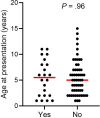Frequency of signs of chronic gastrointestinal disease in dogs after an episode of acute hemorrhagic diarrhea
- PMID: 34894013
- PMCID: PMC8783318
- DOI: 10.1111/jvim.16312
Frequency of signs of chronic gastrointestinal disease in dogs after an episode of acute hemorrhagic diarrhea
Abstract
Background: Acute enteropathy is a trigger of chronic gastrointestinal (GI) disease in humans.
Objective: To report the prevalence of and explore possible risk factors for signs of chronic GI disease in dogs after an episode of acute hemorrhagic diarrhea (AHD).
Animals: One hundred and fifty-one dogs, 80 dogs with a historical diagnosis of AHD, 71 control dogs with no history of AHD.
Methods: In this retrospective longitudinal study, data were collected from dogs with a historical diagnosis of AHD and healthy controls matched by breed, age and sex, aged between 1 year and 15 years of age, for which a follow-up of at least 12 months after enrolment was available. Dog owners responded to a questionnaire to determine the history of signs of chronic GI disease.
Results: There was a higher prevalence of signs of chronic GI disease in the dogs with a previous episode of AHD compared to control dogs (AHD 28%; controls 13%; P = .03; odds ratio = 2.57; confidence interval [CI] 95% 1.12-6.31) over a similar observation time (median 4 years; range, 1-12 years).
Conclusions and clinical importance: Severe intestinal mucosal damage and associated barrier dysfunction might trigger chronic GI disease later in life.
Keywords: AHDS; HGE; IBD; canine; enteropathy; intestinal.
© 2021 The Authors. Journal of Veterinary Internal Medicine published by Wiley Periodicals LLC on behalf of American College of Veterinary Internal Medicine.
Conflict of interest statement
Authors declare no conflict of interest.
Figures


Similar articles
-
Long-Term Follow-Up After Acute Gastroenteritis Caused by Giardia Infection in Juvenile Dogs.J Vet Intern Med. 2025 Jul-Aug;39(4):e70123. doi: 10.1111/jvim.70123. J Vet Intern Med. 2025. PMID: 40448678 Free PMC article.
-
Prevalence of Clostridium perfringens netE and netF toxin genes in the feces of dogs with acute hemorrhagic diarrhea syndrome.J Vet Intern Med. 2019 Jan;33(1):100-105. doi: 10.1111/jvim.15361. Epub 2018 Nov 30. J Vet Intern Med. 2019. PMID: 30499621 Free PMC article.
-
Role of canine circovirus in dogs with acute haemorrhagic diarrhoea.Vet Rec. 2017 Jun 3;180(22):542. doi: 10.1136/vr.103926. Epub 2017 Feb 27. Vet Rec. 2017. PMID: 28242782
-
Acute Hemorrhagic Diarrhea Syndrome in Dogs.Vet Clin North Am Small Anim Pract. 2021 Jan;51(1):79-92. doi: 10.1016/j.cvsm.2020.09.007. Epub 2020 Oct 29. Vet Clin North Am Small Anim Pract. 2021. PMID: 33131918 Review.
-
[Use of antimicrobials in acute canine diarrhea - overview of potential risks, indications and alternatives].Tierarztl Prax Ausg K Kleintiere Heimtiere. 2021 Apr;49(2):110-120. doi: 10.1055/a-1395-2001. Epub 2021 Apr 26. Tierarztl Prax Ausg K Kleintiere Heimtiere. 2021. PMID: 33902119 Review. German.
Cited by
-
Isolation, characterization, and immunomodulatory activity evaluation of probiotic strains from colostrum and canine milk.Front Vet Sci. 2023 Nov 23;10:1266064. doi: 10.3389/fvets.2023.1266064. eCollection 2023. Front Vet Sci. 2023. PMID: 38076565 Free PMC article.
-
Changes in the Oxidative Stress Status of Dogs Affected by Acute Enteropathies.Vet Sci. 2022 Jun 6;9(6):276. doi: 10.3390/vetsci9060276. Vet Sci. 2022. PMID: 35737327 Free PMC article.
-
Pre-illness dietary risk factors in dogs with chronic enteropathy.J Vet Intern Med. 2023 Nov-Dec;37(6):2093-2101. doi: 10.1111/jvim.16872. Epub 2023 Sep 24. J Vet Intern Med. 2023. PMID: 37743693 Free PMC article.
-
Long-Term Follow-Up After Acute Gastroenteritis Caused by Giardia Infection in Juvenile Dogs.J Vet Intern Med. 2025 Jul-Aug;39(4):e70123. doi: 10.1111/jvim.70123. J Vet Intern Med. 2025. PMID: 40448678 Free PMC article.
-
Canine chronic enteropathy-Current state-of-the-art and emerging concepts.Front Vet Sci. 2022 Sep 21;9:923013. doi: 10.3389/fvets.2022.923013. eCollection 2022. Front Vet Sci. 2022. PMID: 36213409 Free PMC article. Review.
References
-
- Garcia Rodriguez LA, Ruigomez A, Panes J. Acute gastroenteritis is followed by an increased risk of inflammatory bowel disease. Gastroenterology. 2006;130:1588‐1594. - PubMed
-
- Chehade M, Mayer L. Oral tolerance and its relation to food hypersensitivities. J Allergy Clin Immunol. 2005;115:3‐12. - PubMed
MeSH terms
LinkOut - more resources
Full Text Sources

